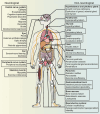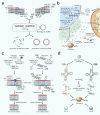Mitochondrial diseases: from molecular mechanisms to therapeutic advances
- PMID: 39788934
- PMCID: PMC11724432
- DOI: 10.1038/s41392-024-02044-3
Mitochondrial diseases: from molecular mechanisms to therapeutic advances
Abstract
Mitochondria are essential for cellular function and viability, serving as central hubs of metabolism and signaling. They possess various metabolic and quality control mechanisms crucial for maintaining normal cellular activities. Mitochondrial genetic disorders can arise from a wide range of mutations in either mitochondrial or nuclear DNA, which encode mitochondrial proteins or other contents. These genetic defects can lead to a breakdown of mitochondrial function and metabolism, such as the collapse of oxidative phosphorylation, one of the mitochondria's most critical functions. Mitochondrial diseases, a common group of genetic disorders, are characterized by significant phenotypic and genetic heterogeneity. Clinical symptoms can manifest in various systems and organs throughout the body, with differing degrees and forms of severity. The complexity of the relationship between mitochondria and mitochondrial diseases results in an inadequate understanding of the genotype-phenotype correlation of these diseases, historically making diagnosis and treatment challenging and often leading to unsatisfactory clinical outcomes. However, recent advancements in research and technology have significantly improved our understanding and management of these conditions. Clinical translations of mitochondria-related therapies are actively progressing. This review focuses on the physiological mechanisms of mitochondria, the pathogenesis of mitochondrial diseases, and potential diagnostic and therapeutic applications. Additionally, this review discusses future perspectives on mitochondrial genetic diseases.
© 2024. The Author(s).
Conflict of interest statement
Competing interests: The authors declare no competing interest.
Figures








Similar articles
-
Unsolved issues related to human mitochondrial diseases.Biochimie. 2014 May;100:171-6. doi: 10.1016/j.biochi.2013.08.012. Epub 2013 Aug 20. Biochimie. 2014. PMID: 23973280 Review.
-
Clinical Approaches for Mitochondrial Diseases.Cells. 2023 Oct 20;12(20):2494. doi: 10.3390/cells12202494. Cells. 2023. PMID: 37887337 Free PMC article. Review.
-
Mechanisms of mitochondrial diseases.Ann Med. 2012 Feb;44(1):41-59. doi: 10.3109/07853890.2011.598547. Epub 2011 Aug 2. Ann Med. 2012. PMID: 21806499
-
Mitochondria in human diseases and animal evolution.Curr Mol Med. 2014;14(10):1245-6. doi: 10.2174/1566524014666141202125126. Curr Mol Med. 2014. PMID: 25470294 No abstract available.
-
Pathogenic Mitochondria DNA Mutations: Current Detection Tools and Interventions.Genes (Basel). 2020 Feb 12;11(2):192. doi: 10.3390/genes11020192. Genes (Basel). 2020. PMID: 32059522 Free PMC article. Review.
Cited by
-
Dual role of lactate in human health and disease.Front Physiol. 2025 Aug 1;16:1621358. doi: 10.3389/fphys.2025.1621358. eCollection 2025. Front Physiol. 2025. PMID: 40821941 Free PMC article. Review.
-
Base editors model mitochondrial disease.Nat Biotechnol. 2025 Jun 3. doi: 10.1038/s41587-025-02706-9. Online ahead of print. Nat Biotechnol. 2025. PMID: 40461780 No abstract available.
-
Influence of a Zombie-like State of the Liver on Drugs and Its Medico-Legal Implications: A Scoping Review.Pharmaceuticals (Basel). 2025 May 24;18(6):787. doi: 10.3390/ph18060787. Pharmaceuticals (Basel). 2025. PMID: 40573181 Free PMC article. Review.
-
Preclinical models of mitochondrial dysfunction: mtDNA and nuclear-encoded regulators in diverse pathologies.Front Aging. 2025 Jun 23;6:1585508. doi: 10.3389/fragi.2025.1585508. eCollection 2025. Front Aging. 2025. PMID: 40625678 Free PMC article. Review.
-
Mitochondrial Quality Control in Health and Disease.MedComm (2020). 2025 Aug 15;6(8):e70319. doi: 10.1002/mco2.70319. eCollection 2025 Aug. MedComm (2020). 2025. PMID: 40821693 Free PMC article. Review.
References
-
- Mitchell, P. Coupling of phosphorylation to electron and hydrogen transfer by a chemi-osmotic type of mechanism. Nature191, 144–148 (1961). - PubMed
-
- Gorman, G. S. et al. Mitochondrial diseases. Nat. Rev. Dis. Prim.2, 16080 (2016). - PubMed
-
- Schapira, A. H. Mitochondrial diseases. Lancet379, 1825–1834 (2012). - PubMed
-
- La Morgia, C., Maresca, A., Caporali, L., Valentino, M. L. & Carelli, V. Mitochondrial diseases in adults. J. Intern Med.287, 592–608 (2020). - PubMed
-
- Gropman, A. L. Diagnosis and treatment of childhood mitochondrial diseases. Curr. Neurol. Neurosci. Rep.1, 185–194 (2001). - PubMed
Publication types
MeSH terms
Substances
Grants and funding
LinkOut - more resources
Full Text Sources
Medical

